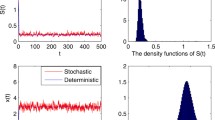Abstract
In this paper, we investigate the asymptotic behavior of a modified chemostat model. We first demonstrate the existence of equilibria. Then, we present a mathematical analysis for the model, the invariance, the positivity, the persistence of the solutions, and the asymptotic global stability of the interior equilibrium. Some numerical simulations are carried out to illustrate the main results.




Similar content being viewed by others
Data Availability
Not applicable.
References
Andrews JF (1969) Dynamic model of the anaerobic digestion process. J Sanit Eng Div 95:95–116
Beretta E, Takeuchi Y (1994) Global stability for chemostat equations with delayed nutrient recycling. Nonlin World 1(3):291–306
Butler GJ, Hsu SB, Waltman P (1985) A mathematical model of the chemostat with periodic washout rate. SIAM J Appl Math 45:435–449
Butler G, Freedman HI, Waltman P (1986) Uniformly persistent systems. Proc Am Math Soc 96:425–430
De Leenheer P, Smith HL (2003) Feedback control for chemostat models. J Math Biol 46(1):48–70
Freedman HI, Waltman P (1977) Mathematical analysis of some three-species food-chain models. Math Biosci 33:257–276
Freedman HI, So JWH, Waltman P (1989) Coexistence in a model of competition in the chemostat incorporating discrete delays. SIAM J Appl Math 49(3):859–870
Freedman HI, Ruan S, Tang M (1994) Uniform persistence and flows near a closed positively invariant set. J Dyn Differ Equ 6:583–600
Gantmacher FR (1959) The theory of matrices. Chelsea Publ Co., New York
Hale JK, Waltman P (1989) Persistence in infinite-dimensional systems. SIAM J Numer Anal 20:388–395
Hamra MA, Yadi K (2017) Asymptotic behavior of a chemostat model with constant recycle sludge concentration. Acta Biotheor 65:233–252
Hsu SB, Smith HL, Waltman P (1996) Competitive exclusion and coexistence for competitive systems on ordered Banach spaces. Trans Am Math Soc 348(10):4083–4094
Lenas P, Pavlou S (1994) Periodic, quasi-periodic, and chaotic coexistence of two competing microbial populations in a periodically operated chemostat. Math Biosci 121:61–110
Marsili-Libelli S (1989) Modelling, identification and control of the activated sludge process. Adv Biochem Eng Biotechnol 38:90–148
Pavlou S, Kevrekidis IG, Lyberatos G (1990) On the coexistence of competing microbial species in a chemostat under cycling. Biotechnol Bioeng 35:224–232
Pilyugin SS, Waltman P (1999) Competition in the unstirred chemostat with periodic input and washout. SIAM J Appl Math 59(4):1157–1177
Smith HL (1981) Competitive coexistence in an oscillating chemostat. SIAM J Appl Math 40:498–522
Smith HL, Waltman P (1995) The theory of the chemostat: dynamics of microbial competition. Cambridge University Press, Cambridge, UK
Funding
Not applicable.
Author information
Authors and Affiliations
Corresponding author
Ethics declarations
Ethical approval
Not applicable.
Additional information
Publisher's Note
Springer Nature remains neutral with regard to jurisdictional claims in published maps and institutional affiliations.
Rights and permissions
Springer Nature or its licensor (e.g. a society or other partner) holds exclusive rights to this article under a publishing agreement with the author(s) or other rightsholder(s); author self-archiving of the accepted manuscript version of this article is solely governed by the terms of such publishing agreement and applicable law.
About this article
Cite this article
Hamra, M.A. Mathematical analysis of a modified Volterra-Leslie chemostat Model. Theory Biosci. (2024). https://doi.org/10.1007/s12064-024-00415-6
Received:
Accepted:
Published:
DOI: https://doi.org/10.1007/s12064-024-00415-6




